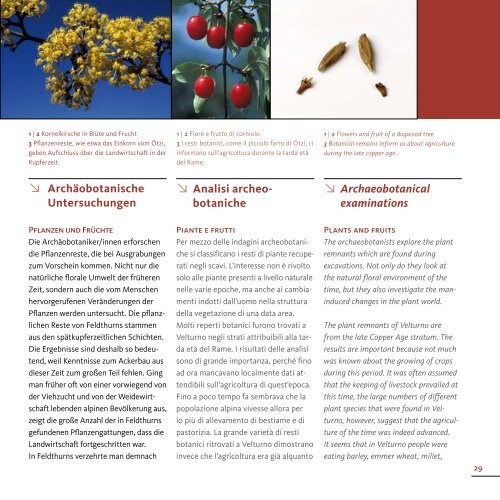Un regno di pietre. - Rete Civica dell'Alto Adige
Un regno di pietre. - Rete Civica dell'Alto Adige
Un regno di pietre. - Rete Civica dell'Alto Adige
Create successful ePaper yourself
Turn your PDF publications into a flip-book with our unique Google optimized e-Paper software.
1 | 2 Kornelkirsche in Blüte und Frucht<br />
3 Pflanzenreste, wie etwa das Einkorn vom Ötzi,<br />
geben Aufschluss über <strong>di</strong>e Landwirtschaft in der<br />
Kupferzeit.<br />
W Archäobotanische<br />
<strong>Un</strong>tersuchungen<br />
Pflanzen und Früchte<br />
Die Archäobotaniker/innen erforschen<br />
<strong>di</strong>e Pflanzenreste, <strong>di</strong>e bei Ausgrabungen<br />
zum Vorschein kommen. Nicht nur <strong>di</strong>e<br />
natürliche florale Umwelt der früheren<br />
Zeit, sondern auch <strong>di</strong>e vom Menschen<br />
hervorgerufenen Veränderungen der<br />
Pflanzen werden untersucht. Die pflanzlichen<br />
Reste von Feldthurns stammen<br />
aus den spätkupferzeitlichen Schichten.<br />
Die Ergebnisse sind deshalb so bedeutend,<br />
weil Kenntnisse zum Ackerbau aus<br />
<strong>di</strong>eser Zeit zum großen Teil fehlen. Ging<br />
man früher oft von einer vorwiegend von<br />
der Viehzucht und von der Weidewirtschaft<br />
lebenden alpinen Bevölkerung aus,<br />
zeigt <strong>di</strong>e große Anzahl der in Feldthurns<br />
gefundenen Pflanzengattungen, dass <strong>di</strong>e<br />
Landwirtschaft fortgeschritten war.<br />
In Feldthurns verzehrte man demnach<br />
1 | 2 Fiore e frutto <strong>di</strong> corniolo<br />
3 I resti botanici, come il piccolo farro <strong>di</strong> Ötzi, ci<br />
informano sull’agricoltura durante la tarda età<br />
del Rame.<br />
W Analisi archeo-<br />
botaniche<br />
Piante e frutti<br />
Per mezzo delle indagini archeobotaniche<br />
si classificano i resti <strong>di</strong> piante recuperati<br />
negli scavi. L’interesse non è rivolto<br />
solo alle piante presenti a livello naturale<br />
nelle varie epoche, ma anche ai cambiamenti<br />
indotti dall’uomo nella struttura<br />
della vegetazione <strong>di</strong> una data area.<br />
Molti reperti botanici furono trovati a<br />
Velturno negli strati attribuibili alla tarda<br />
età del Rame. I risultati delle analisi<br />
sono <strong>di</strong> grande importanza, perché fino<br />
ad ora mancavano localmente dati atten<strong>di</strong>bili<br />
sull’agricoltura <strong>di</strong> quest’epoca.<br />
Fino a poco tempo fa sembrava che la<br />
popolazione alpina vivesse allora per<br />
lo più <strong>di</strong> allevamento <strong>di</strong> bestiame e <strong>di</strong><br />
pastorizia. La grande varietà <strong>di</strong> resti<br />
botanici ritrovati a Velturno <strong>di</strong>mostrano<br />
invece che l’agricoltura era già alquanto<br />
1 | 2 Flowers and fruit of a dogwood tree<br />
3 Botanical remains inform us about agriculture<br />
during the late copper age..<br />
W Archaeobotanical<br />
examinations<br />
Plants and fruits<br />
The archaeobotanists explore the plant<br />
remnants which are found during<br />
excavations. Not only do they look at<br />
the natural floral environment of the<br />
time, but they also investigate the maninduced<br />
changes in the plant world.<br />
The plant remnants of Velturno are<br />
from the late Copper Age stratum. The<br />
results are important because not much<br />
was known about the growing of crops<br />
during this period. It was often assumed<br />
that the keeping of livestock prevailed at<br />
this time, the large numbers of <strong>di</strong>fferent<br />
plant species that were found in Velturno,<br />
however, suggest that the agriculture<br />
of the time was indeed advanced.<br />
It seems that in Velturno people were<br />
eating barley, emmer wheat, millet,<br />
29



